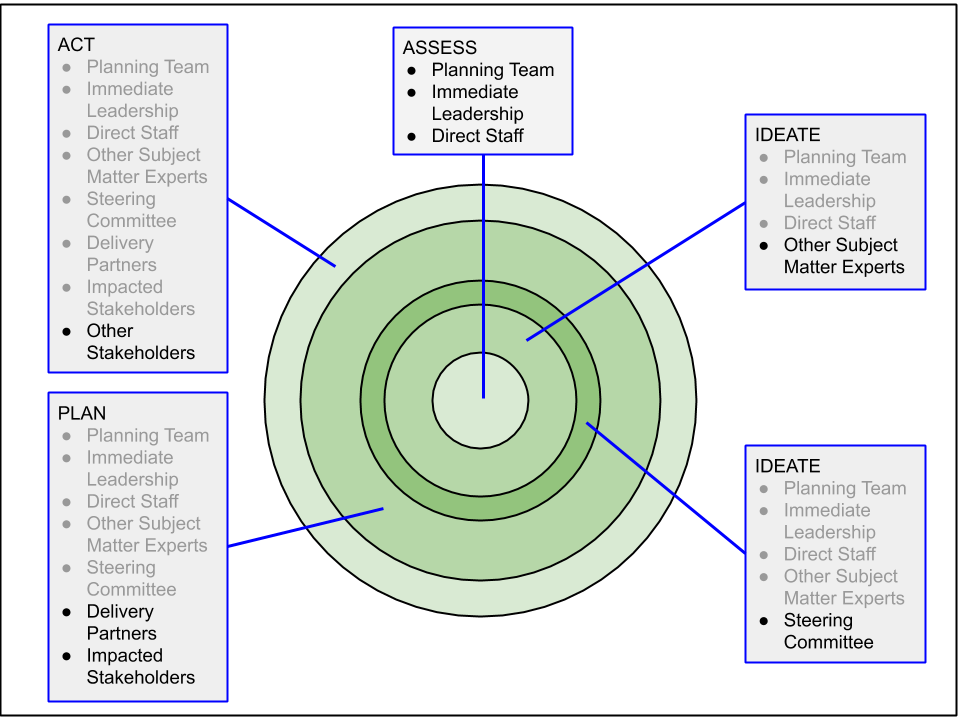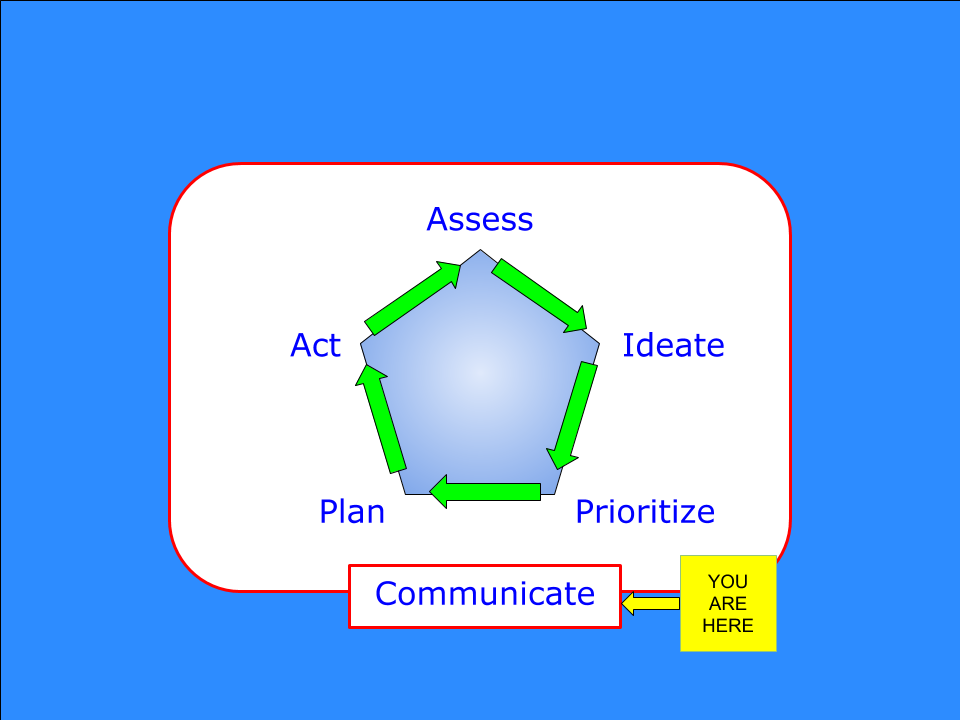Introduction
The ability to communicate is one of the most important skills a manager can develop. This is especially true throughout the planning cycle. By effectively communicating about your plans, you significantly increase your odds for success. The Communicate phase is made up of activities that are performed in each of the other phases.
- Phase 1 – Assess
- Phase 2 – Ideate
- Phase 3 – Prioritize
- Phase 4 – Plan
- Phase 5 – Act
- Phase 6 – Communicate – this article!

Each of the other articles in this series have a section on communication that provides a high-level summary of the tasks. This article provides the details.
There are two other articles that you should read as prerequisites: Understanding Stakeholders and Six Questions That Will Improve Your Communication Skills. I recommend you read them before proceeding. Start with Stakeholders, then read Six Questions. The text below assumes you are familiar with the contents of those two articles.
Objectives and Outputs of Communicate
The objective of the Communicate phase is to provide the right information to the right stakeholders, using the right format and delivery method at the right time.
The outputs of this phase will be:
- Communications materials will be created or updated. These include the stakeholder analysis template and matrix, the communications plan template, message triangles, and documents or other media containing the messages.
- Messages delivered through appropriate channels.
Steps in the Process
There are 6 steps in the Communicate phase:
- Update the stakeholder analysis
- Review the output of the current phase and ask the six questions
- Complete your communication planning
- Create message triangles
- Create the communication materials
- Deliver the messages
These steps will be repeated during the “Communication Status and Results” section of each of the five other phases.
Update the Stakeholder Analysis
In order to ensure that you reach the right group of stakeholders, you should perform an initial stakeholder analysis during the Assess phase. Then, in each subsequent phase, update your stakeholder analysis records with the results from the last phase. Note what you and your team learned from recent interactions with your stakeholders. Consider what worked well and what needs to be improved, then make the necessary changes.
In the early phases, your audience will probably be a subset of your stakeholders. During the Assess phase, your audience will likely be limited to some of your high power stakeholders and your planning team. This makes sense, given the topics you will be considering. Much of what you do in Assess, Ideate and Prioritize will focus on possibilities. Some of the ideas may be very sensitive or confidential. This is not material suitable for broad circulation.
As noted below, as you progress through the planning cycle, you will ask “who else needs to know?” at each phase. By answering that question you will expand your audience. You may also identify new stakeholder groups or groups omitted during earlier analyses.
You can imagine your audience growing like a set of concentric circles, as shown in the illustration below.

Your audience will grow with each successive phase until, during the Act phase, you will be communicating with a large and diverse group of stakeholders. Tools like the message triangle and communications plan, described in the Six Questions article and in the section below, will help you organize your messages and get them to the right people at the right time.
Review the Output of the Current Phase and Ask the Six Questions
In “Six Questions That Will Improve Your Communication Skills”, I recommended asking Why? Who? What? How? Where? and When? as a way to gain the insights that will allow you to create clear, consistent and concise communications for different stakeholder groups. Ask the questions as part of each phase of the planning cycle. The answers will shape your communication agenda and the messages you create.
Here is an example from the Assess phase:
- Why? To inform key stakeholders about the activities and outcomes of the Assess phase.
- Who? Steering Committee members.
- What? Develop a message triangle. Key points and supporting details should include the assessment topic, who participated, the output of the SWOT / PEST analysis and the relevant topics identified.
- How? / Where? Written summary report sent via email to each committee member. Presentation at next committee meeting.
- When? Report sent one week before Steering Committee meeting.
(I will add a similar example to the Ideate article and will include examples in the remaining articles for the Prioritize, Plan and Act phases.)
Complete Your Communication Planning
The Communications Plan, also described in Six Questions, gives you the blueprint for creating the messages you need to address the interests of your stakeholder groups. It will illustrate which stakeholder groups need which messages, how they will be delivered and by whom. (Remember: You don’t have to do it all by yourself!)

Download a communications plan template.
Some communications will be frequent – occurring throughout each phase of the planning cycle. For example, you will probably send messages to some high power stakeholders as part of every phase. Other stakeholders will be engaged at later steps in the process. During the Plan phase, for example, you will need to communicate with any stakeholders or partners upon whom you’ll depend to execute some part of your plan. You’ll also have to communicate with groups who may be impacted by your plans as you execute them in the Act phase.
Create Message Triangles
As noted in Six Questions, message triangles help you focus your message and identify the key points you want to deliver to specific audiences.

Download a message triangle template.
As you progress through the phases, you may find that you need to create multiple message triangles as the basis for messages to different stakeholder groups. The key points you include in a presentation to inform a group of interested project sponsors will be somewhat different from the items you use to persuade a group of skeptical, low power stakeholders to get on board with your initiative.
Create the Communications Materials
With an updated communications plan and message triangles, you can now develop the actual documents and media, such as presentations, reports, podcast scripts, newsletters or posters, that will be used to deliver your messages. Even though these will be used for different purposes with different audiences, there should still be common themes across all the materials and delivery channels. This is particularly important if you are communicating about a major change initiative. Having consistent themes, images and key points in all your communications helps reinforce your message and can raise the profile of your initiatives.
Repeating the key themes across multiple messages and channels can create a sense of familiarity in the minds of your stakeholders. There’s an old saying that “familiarity breed contempt”. In this context, familiarity can also reinforce the momentum of your work and predispose stakeholders to support it.
One tactic I used when leading large programs was to always begin my communications by reminding the audience of the purpose and objectives of the program. This was either a simple statement in the opening paragraph of a written message or a set of bullet points on the first slide of every presentation. Doing that helped focus the stakeholder’s attention on the message that follows. It is particularly important when communicating with busy executives who have multiple competing priorities and may only hear about the initiative every two or three months. My rule of thumb was “never assume that they remember your mission”.
Deliver the Messages
Your communication plan should dictate your schedule and the priorities for which messages get delivered first. Depending on the number of messages and the need to do face-to-face briefings or presentations, your delivery could stretch over several weeks or months. If this happens, you may decide to begin the next phase of the planning cycle while the communication activities proceed.
Conclusion
Communication is an important part of your planning effort. In each phase of the planning cycle, you will need to update your stakeholder analysis to identify any additional individuals or groups that should receive messages about the planning effort. By asking the Six Questions, you will identify the critical attributes of the messages for each stakeholder group. The message triangles will help ensure that your communications are clear, consistent and concise, tailored to the needs of various stakeholder groups, but composed with common themes.
By implementing these actionable ideas and utilizing the tools, you can ensure that the right messages are delivered to the right people at the right time in the right format.
To your success,


What’s on your mind today?
Do you have a management problem or question that I could help answer?
If so, then let’s talk.
Click the button below and use the Contact form to request a complementary 30 minute chat. We’ll work together to identify some actionable ideas just for you.

This is good stuff!